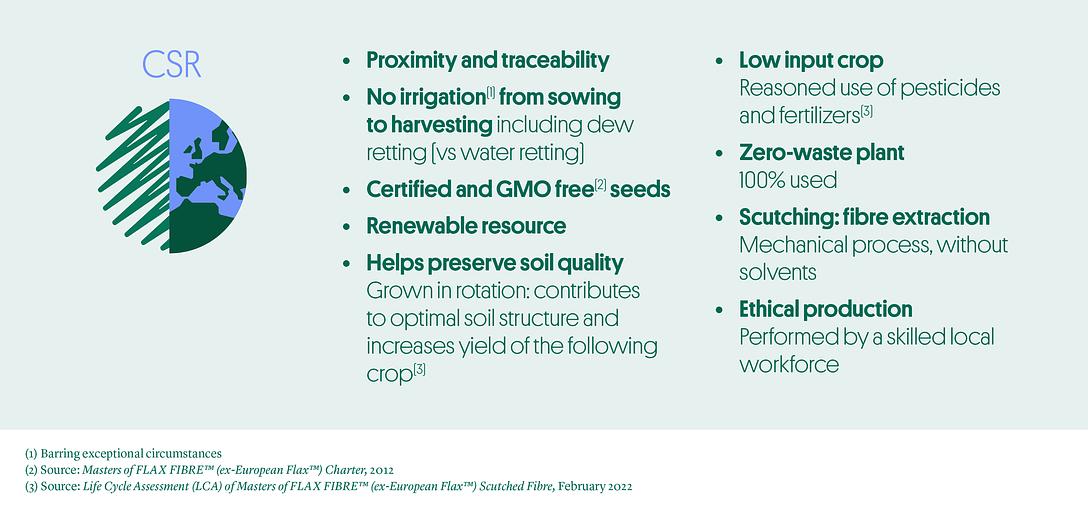European Flax: environmentally responsible
Through its intrinsic properties, European flax fibre is indispensable to businesses seeking premium quality, renewable material.

Through its intrinsic properties, European flax fibre is indispensable to businesses seeking premium quality, renewable material.

Masters of Flax Fibre™ (ex-European Flax™) is a natural plant fibre that uses low-impact production methods: grown on rotation, it is an eco-friendly crop that requires no irrigation*, no defoliants and is GMO-free. The transformation process from plant to fibre requires no additional water and all parts of the plant are valued.
*barring exceptional circumstances.

Flax is planted on rotation, normally every six to seven years on the same plot of land, alternating with other crops. This helps preserve soil quality, prevent disease, and promote flax quality.
Flax growing also helps obtain optimal soil quality* and increases the yield of the following crop, making it an excellent break crop (first crop in a rotation cycle).
*Flax can have beneficial effects on other crops by structuring the soil and reducing certain pests. Introducing flax into rotations makes it possible to lengthen the return period for other crops, thereby limiting the diseases and pests that remain in the soil, as well as to break the cycle of certain weeds (...) . The beneficial effect of fibre flax on soil structure is usually reflected in an average yield increase of 5% for the following crop.
Source: Lin fibre : culture et transformation. ARVALIS - Institut du végétal, 2013.
Flax grown in Western Europe does not require irrigation barring exceptional circumstances at a critical stage of the plant’s growth.
*barring exceptional circumstances.
The official European catalogue of species and varieties does not contain genetically modified flax. All Western European fibre producers have also committed to a GMO-free crop by joining the European Flax™ Charter starting in 2012. As a result, the industry is conducting varietal research to create varieties that would be more resistant to climatic shock and disease.
Flax growing is low in inputs (fertilisers and pesticides) thanks to the very nature of flax and to the responsible farming practices used by producers of certified European Flax™. Flax has a low nitrogen requirement, and fertilisers - nitrogen, phosphorus and potassium - are managed based on soil analysis in order to meet the needs of the crop(1).
(1)Source: Life Cycle Assessment of European Flax™, compliant with the PEF method, 2022, CELC (now known as the Alliance for European Flax-Linen & Hemp).
After pulling, the first stage of flax fibre processing is retting which breaks down the pectose, which binds the textile fibres to the woody part of the stem. European Flax™ undergoes 100% dew retting, where it is subjected to the effects of rain, dew, the sun and natural microorganisms in the soil, in contrast to water retting, used in other regions of the world.
The second processing phase is scutching, an entirely mechanical process that consists of extracting the fibres and separating them from the woody centre of the stem; the shives. The entire plant can be used, and nothing is wasted. The long and short fibres are used for fabrics and technical textiles; the shives are used for mulch, animal bedding, building panels and heating; the seeds can be used for oil; and even the dust is used for compost.
Western European growing and scutching practices, and particularly the average common growing itinerary, are explained, quantified and published in the Summary of Life Cycle Analysis of European Flax™, compliant with the PEF method, 2022, CELC (now known as the Alliance for European Flax-Linen & Hemp). Through this study, it is also possible to measure the environmental impact of responsible Western European flax growing practices and to monitor them for the purpose of further improvements.
NB: Flax is also grown on organic farms. Flax growing is guaranteed to be free of synthetic substances (the use of mineral fertiliser, herbicides, fungicides and regulators is forbidden), which ensures the complete absence of the residue of these products in the fibre and soil after pulling. In 2021, the organic flax growing area (France, Belgium and the Netherlands) was estimated at between 320 and 350 hectares, or 0.3% of the total European fibre flax growing area.

A local crop, flax is grown in Western Europe on a wide coastal strip of land stretching from Caen to Amsterdam: France, Belgium and the Netherlands which accounts for three-quarters of global flax fibre production.
It is a premium and sustainable fibre and its traceability is certified by:
{{message}}